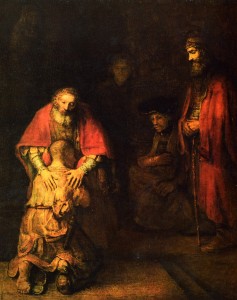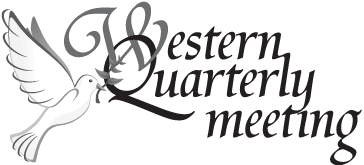*This article originally appeared in West Grove Meeting‘s August Newsletter.
A Meditation
In the beginning . . .
The grace of the Lord Jesus be with God’s people. Amen.
The Book of Beginnings,
through the Apocrypha,
to the end of The Revelation of John
My love affair with the Bible began as a child. Upon graduating to fourth grade in Sunday School we were given a Bible: fake black leather cover, gold-embossed letters, tissue-thin pages. I was led to read it often and can remember sitting in my bedroom, red pencil in hand, underlining passages that spoke to me. All the while understanding through the lens of the Presbyterian Church.
As an adult I was a part of and led many Bible studies. The more I studied, the less satisfied I became with the traditional teachings and commentaries. For Old Testament books I began looking for Jewish commentaries figuring that since it was written by and for Jews, going to the source might be worth while. Because finding other sources of information on the New Testament was more challenging I began reading books on how the Bible came to be and discovered a whole world of scholarship that the Church does not share with the laity. . . and a faith that was supported by the teachings of the Church came crashing down around my ears. Once the dust from the rubble cleared from my eyes and brain, there began an interesting, exciting, and enlightening journey.
Part of the discovery is that I need new language of faith. The ‘old’ words are so filled with baggage that they no longer resonate with the heart.
Another part of the journey has led me to see the Bible with different eyes. The Bible is ‘sacred literature’, not because it is “God’s Word writ large” but because it is the timeless story of all humankind told from the perspective of the Hebrew people. In the words of Abraham Joshua Heschel it is “the story of God in search of Man and Man in search of God”. It is the story of nations; the stories of good people doing incredibly stupid and cruel things; stories of people not sure of their ability to do things beyond their imagining; tales of intended meanness turning out to be blessings in disguise. Within the stories beats the heart of the Divine Mystery, who longs for us to live lives full of goodness; of a God who is not separate from us but deep within while we at the same time are deep within the Mystery.
The stories of the Bible are our myths. The myths through which we find sign posts for our lives. We can read the story about King David and his affair with Bathsheba, wife of Uriah, one of David’s generals. When Bathsheba found she was pregnant with David’s baby, and there was no way to pretend that Uriah was the father, since he had been away on military duty, David contrived to have Uriah sent to the very front of the battle line where he knew Uriah was sure to be killed. We can read about Jonah who was given a mission by God to go and preach to the people of Ninevah, but, because he did not want them to repent and turn back to God, Jonah hopped a ride on a ship to run away, and we know where that got him. Or, we can read about Abraham who instructed Sarah to tell anyone who asked that she was his sister so that he would not be killed by another who might desire her when they went down to Egypt. In these stories and others we see ourselves: perhaps when we have done or said something that we knew would harm another but our desire for the end result was so strong that we did it anyway, and in this seeing we find mercy and forgiveness for those we put on pedestals.
There are terrible stories of brutality in the Old Testament, of God telling the people of Israel to invade another land and kill all of the men, women, children, oxen and sheep. Are these the words of God? Or, perhaps better understood as the history that Israel wrote hundreds of years later to justify how they took over a land? Perhaps there might be the realization that these stories are similar to the stories we tell of the founding of this country, of our Manifest Destiny to the land, which implied that those who were already here were best described as ‘wild savages’ and therefore okay to kill, round-up and send off to parcels of land we did not want.
There is, in the story of Hagar, the truth that we find life when we look up and out rather than dwelling on our own selves.
Sometimes in the story of the Prodigal Son, I see myself as the parent, ignoring neighborly ridicule to warmly welcome back the child who strayed; or I’m the wayward daughter who has to swallow my pride to return to relationship with my parent; and sometimes I am the elder sister, the one who stayed home, was obedient and deeply resented the return of the stray.
 Knowing the history of how the Bible came to be is really important. Reading with an eye toward how you/I fit into the stories is important. Coming to an understanding of what you mean by the word ‘God’ is very important. Once in a while, dust off the cover, pick it up and do some reading. Wonder about what you are reading; what those ancient stories have to say about life today.
Knowing the history of how the Bible came to be is really important. Reading with an eye toward how you/I fit into the stories is important. Coming to an understanding of what you mean by the word ‘God’ is very important. Once in a while, dust off the cover, pick it up and do some reading. Wonder about what you are reading; what those ancient stories have to say about life today.
Sometimes when in despair, I find comfort in the lamentations found in the Psalms; and sometimes the words of Isaiah make me feel like soaring on eagle’s wings.
And, sometimes, I end up just scratching my head, saying “Really”?
As with any piece of literature, it is important to have some understanding of the context in which it was written. Who did the writing, when, and to what purpose? Because the books of the Bible follow a fairly standard order, it is very easy to assume that they are in chronological sequence. Not so. Everything in the Old Testament was written many hundreds of years after the fact. The ‘facts’ are not necessarily literal and they are not sequential. The earliest of the New Testament writings were letters written by Paul at least thirty years after Jesus’ death, and the Gospels were not written until almost the turn of the first century. The Gospels are not placed in chronological order of writing. Mark was first, followed by Matthew, Luke and then John. Matthew and Luke used parts of Mark’s story and added their own bits and pieces to suit the story and the times they were writing in.
The New Testament was not compiled and the canon closed until the fourth century, and nowhere in the world is there a set of the original texts for either the Old or New Testaments. There are parts and pieces and fragments in museums throughout the world, and those pieces and fragments are copies of copies of copies of copies. The pieces are compared, textual disparities noted, and, to the best of their abilities, scholars decide which versions are probably truest to the originals.
Given all of the challenges at discerning what was the original story, the original intent – the question of “Why bother?” comes up. Despite the issues, this is still the story of a particular people, the Jews, and the way by which they know that which we call God. It is the story of those Jews and Gentiles who believed that Jesus was the living embodiment of The Path, The Way. It is the foundation myth of those of us born into the Judeo-Christian culture, and, within the stories, we can see ourselves.
Sometimes, because the stories are so familiar, it is difficult to ‘see’ the hidden truth. For me, that is when the stories and myths of other cultures help. Reading Buddhist literature in particular has opened my eyes to truths in ‘my’ sacred literature, giving me pause and “A-Ha!” moments.
-Alyce Denver is a member of West Grove Monthly Meeting

Comments are closed.